| Listing 1 - 10 of 10 |
Sort by
|
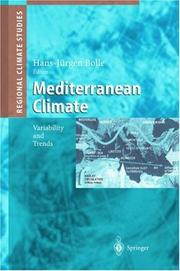
ISBN: 3540438386 3642628621 3642556574 9783540438380 Year: 2003 Publisher: Berlin: Springer,
Abstract | Keywords | Export | Availability | Bookmark
 Loading...
Loading...Choose an application
- Reference Manager
- EndNote
- RefWorks (Direct export to RefWorks)
Mohamed Larbi Selassi Deputy Director of the National Meteorology, Morocco Welcome address (translated from French) WMO, WCRP, Medias-France and scientific institutions representatives, ladies and gentlemen, to thank WMO and MEDIAS-France, who have honoured us by I want first organizing the two workshops, climate indices in Africa and data assessment for global change research in the Mediterranean region, in Casablanca and I welcome all of you here in Morocco. It is with great pleasure that I open these two workshops on behalf of myself and on behalf of the Direction of the Meteorologie N ationale of Morocco. Climate change is becoming the focus of the international community because of its global scale and unpredictable effects, the numerous impacts it causes, its global feature and the complexity of the solutions that can mitigate its impacts. Global warming and the greenhouse effect became a subject of study at the international level since the United Nations Conference on the human environment that was held in Stockholm in 1972. The research and coordination efforts that have been made in this area have led to an "International Scientific consensus". High level meetings like those held in Toronto in 1988, in Lahaye in 1989 and in Geneva in 1990, did confirm the greenhouse threat and the emergency to treat it.
Climatic changes --- Mediterranean Region --- Climate. --- Earth sciences. --- Atmospheric sciences. --- Geotechnical engineering. --- Geography. --- Space sciences. --- Air pollution. --- Earth Sciences. --- Atmospheric Sciences. --- Atmospheric Protection/Air Quality Control/Air Pollution. --- Extraterrestrial Physics, Space Sciences. --- Geotechnical Engineering & Applied Earth Sciences. --- Geography, general. --- Space Sciences (including Extraterrestrial Physics, Space Exploration and Astronautics). --- Cosmography --- Earth sciences --- World history --- Engineering, Geotechnical --- Geotechnics --- Geotechnology --- Engineering geology --- Science and space --- Space research --- Cosmology --- Science --- Astronomy --- Air --- Air contaminants --- Air pollutants --- Air pollution --- Air pollution control --- Air toxics --- Airborne pollutants --- Atmosphere --- Contaminants, Air --- Control of air pollution --- Pollutants, Air --- Toxics, Air --- Pollution --- Air quality --- Atmospheric deposition --- Atmospheric sciences --- Control --- Climatic changes - Mediterranean Region. --- Mediterranean Region - Climate.

ISBN: 0306482088 1402072252 Year: 2003 Publisher: New York : Kluwer Academic Publishers,
Abstract | Keywords | Export | Availability | Bookmark
 Loading...
Loading...Choose an application
- Reference Manager
- EndNote
- RefWorks (Direct export to RefWorks)
Small invisible particles in the urban air, especially those produced by human activities, have recently stimulated intense scrutiny, debate, regulation, and legal proceedings. The stakes are high, both with respect to health impacts and economic costs, and the methods used previously to resolve similar issues are no longer adequate. Everyone on earth inhales thousands to millions of particles in each breath, so if urban particulate air pollution—particulate matter (PM)—is significantly hazardous, the negative impact on health could be staggering. Yet the activities that generate PM, such as farming, manufacturing, mining, transportation, and generating electricity, are themselves essential to human health and welfare. Scientists, regulators, legislators, activists, judges, lawyers, journalists, and representatives of the business community are actively involved in addressing the question of what should be done. This complex issue presents opportunities for critically assessing the relevant knowledge and for adopting more rigorous approaches to this and similar problems. What is the PM controversy, and why is it a good case study for how science and public policy might better interface? The PM controversy is the sum of the frequently heated debates related to the potential health risks from urban PM.
Environment. --- Public health. --- Epidemiology. --- Ecotoxicology. --- Air pollution. --- Atmospheric Protection/Air Quality Control/Air Pollution. --- Public Health. --- Air --- Air contaminants --- Air pollutants --- Air pollution --- Air pollution control --- Air toxics --- Airborne pollutants --- Atmosphere --- Contaminants, Air --- Control of air pollution --- Pollutants, Air --- Toxics, Air --- Pollution --- Air quality --- Atmospheric deposition --- Ecotoxicology --- Pollutants --- Environmental health --- Toxicology --- Diseases --- Public health --- Community health --- Health services --- Hygiene, Public --- Hygiene, Social --- Public health services --- Public hygiene --- Social hygiene --- Health --- Human services --- Biosecurity --- Health literacy --- Medicine, Preventive --- National health services --- Sanitation --- Control --- Particles --- Environmental aspects.
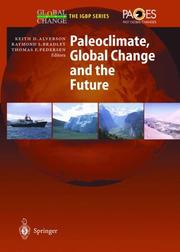
ISSN: 16192435 ISBN: 3540424024 3642626920 3642558283 9783540424024 Year: 2003 Publisher: Berlin: Springer,
Abstract | Keywords | Export | Availability | Bookmark
 Loading...
Loading...Choose an application
- Reference Manager
- EndNote
- RefWorks (Direct export to RefWorks)
This book provides a synthesis of the past decade of research into global changes that occurred in the earth system in the past. Focus is achieved by concentrating on those changes in the Earth's past environment that best inform our evaluation of current and future global changes and their consequences for human populations. The book stands as a ten year milestone in the operation of the Past Global Changes (PAGES) Project of the International Geosphere-Biosphere Programme (IGBP). It seeks to provide a quantitative understanding of the Earth’s environment in the geologically recent past and to define the envelope of natural environmental variability against which anthropogenic impacts on the Earth System may be assessed.
Paleoclimatology. --- Global environmental change. --- Paléoclimatologie --- Changement global (Environnement) --- Paléoclimatologie --- Atmospheric sciences. --- Geoecology. --- Environmental geology. --- Nature conservation. --- Geobiology. --- Paleontology . --- Air pollution. --- Atmospheric Sciences. --- Geoecology/Natural Processes. --- Nature Conservation. --- Biogeosciences. --- Paleontology. --- Atmospheric Protection/Air Quality Control/Air Pollution. --- Air --- Air contaminants --- Air pollutants --- Air pollution --- Air pollution control --- Air toxics --- Airborne pollutants --- Atmosphere --- Contaminants, Air --- Control of air pollution --- Pollutants, Air --- Toxics, Air --- Pollution --- Air quality --- Atmospheric deposition --- Fossilogy --- Fossilology --- Palaeontology --- Paleontology, Zoological --- Paleozoology --- Historical geology --- Zoology --- Fossils --- Prehistoric animals in motion pictures --- Biology --- Earth sciences --- Biosphere --- Conservation of nature --- Nature --- Nature protection --- Protection of nature --- Conservation of natural resources --- Applied ecology --- Conservation biology --- Endangered ecosystems --- Natural areas --- Geoecology --- Environmental protection --- Physical geology --- Atmospheric sciences --- Control --- Conservation
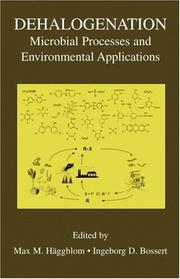
ISBN: 0306480115 1402074069 Year: 2003 Publisher: Boston, Massachusetts : Kluwer Academic Pub.,
Abstract | Keywords | Export | Availability | Bookmark
 Loading...
Loading...Choose an application
- Reference Manager
- EndNote
- RefWorks (Direct export to RefWorks)
Halogenated organic compounds constitute one of the largest groups of environmental chemicals. The industrial production of new halogenated organic compounds has increased throughout the last century peaking in the 1960s, and continuing in widespread use today. Organohalides are integral to a variety of industrial applications, including use as solvents, degreasing agents, biocides, pharmaceuticals, plasticizers, hydraulic and heat transfer fluids, and intermediates for chemical synthesis, to name a few. It is important to recognize the beneficial aspects of halogenated organic compounds, as well as their potentially deleterious impact on the environment and health. Recognition of the adverse environmental effects of many types of organohalide compounds has led to efforts to reduce or eliminate the most problematic ones. Although organohalide compounds are typically considered to be anthropogenic industrial compounds, they have their counterpart in several thousands of natural biogenic and geogenic organohalides, representing most classes of organic chemicals. Natural sources account for a significant portion of the global organohalogen budget. This volume authored by recognized experts in the field provides a current perspective on how both natural and synthetic organohalides are formed and degraded, and how these processes are incorporated into a global halogen cycle. The focus is on microbial processes, since these play a major role both in the production and degradation, i. e. , cycling of halogenated organic compounds in the environment. This book is organized into five parts. Part I, Introduction, provides a global perspective on the issues of organohalides and their fate in the environment.
Environment. --- Biochemistry. --- Ecotoxicology. --- Environmental engineering. --- Biotechnology. --- Air pollution. --- Atmospheric Protection/Air Quality Control/Air Pollution. --- Environmental Engineering/Biotechnology. --- Biochemistry, general. --- Environment, general. --- 579.6 --- 579.6 Applied microbiology --- Applied microbiology --- Halophilic microorganisms --- Organohalogen compounds --- Halogen organic compounds --- Halogenated organic compounds --- Halogen compounds --- Organic compounds --- Micro-organisms, Halophilic --- Halophilic organisms --- Microorganisms --- Environmental aspects --- Metabolic detoxification --- Metabolism --- Ecotoxicology --- Pollutants --- Pollution --- Environmental health --- Toxicology --- Biological chemistry --- Chemical composition of organisms --- Organisms --- Physiological chemistry --- Biology --- Chemistry --- Medical sciences --- Chemical engineering --- Genetic engineering --- Environmental control --- Environmental effects --- Environmental stresses --- Engineering --- Environmental protection --- Sustainable engineering --- Air --- Air contaminants --- Air pollutants --- Air pollution --- Air pollution control --- Air toxics --- Airborne pollutants --- Atmosphere --- Contaminants, Air --- Control of air pollution --- Pollutants, Air --- Toxics, Air --- Air quality --- Atmospheric deposition --- Composition --- Control --- Halophilic microorganisms. --- Environmental aspects. --- Metabolic detoxification. --- Metabolism.
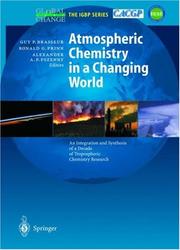
ISSN: 16192435 ISBN: 3540430504 3642623964 3642189849 9783540430506 Year: 2003 Publisher: Berlin: Springer,
Abstract | Keywords | Export | Availability | Bookmark
 Loading...
Loading...Choose an application
- Reference Manager
- EndNote
- RefWorks (Direct export to RefWorks)
This unique volume summarizes and integrates more than a decade of atmospheric chemistry research, carried out under the auspices of the International Global Atmospheric Chemistry (IGAC) Project of the International Geosphere-Biosphere Programme (IGBP). It is part of a series being written by each of the IGBP core projects. During the period under consideration, great progress has been made in the science, computing, modelling and observational techniques; methods have also improved. Suggestions for the highest priority research for the next decade are made. The volume was written by leaders in the field of atmospheric chemistry research, and includes important information regarding impacts on the environment reinforced by solid scientific results.
Atmospheric chemistry. --- Atmospheric chemistry --- Chemistry, Physical and theoretical --- Atmospheric science --- Atmospheric sciences. --- Geoecology. --- Environmental geology. --- Nature conservation. --- Air pollution. --- Ecotoxicology. --- Analytical chemistry. --- Atmospheric Sciences. --- Geoecology/Natural Processes. --- Nature Conservation. --- Atmospheric Protection/Air Quality Control/Air Pollution. --- Analytical Chemistry. --- Analysis, Chemical --- Analytic chemistry --- Chemical analysis --- Chemistry, Analytic --- Chemistry --- Ecotoxicology --- Pollutants --- Pollution --- Environmental health --- Toxicology --- Air --- Air contaminants --- Air pollutants --- Air pollution --- Air pollution control --- Air toxics --- Airborne pollutants --- Atmosphere --- Contaminants, Air --- Control of air pollution --- Pollutants, Air --- Toxics, Air --- Air quality --- Atmospheric deposition --- Conservation of nature --- Nature --- Nature protection --- Protection of nature --- Conservation of natural resources --- Applied ecology --- Conservation biology --- Endangered ecosystems --- Natural areas --- Geoecology --- Environmental protection --- Physical geology --- Atmospheric sciences --- Earth sciences --- Control --- Conservation
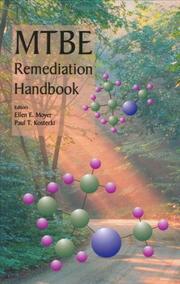
ISBN: 1884940293 1461348897 1461500214 Year: 2003 Publisher: Amherst, Mass. : Amherst Scientific Publishers,
Abstract | Keywords | Export | Availability | Bookmark
 Loading...
Loading...Choose an application
- Reference Manager
- EndNote
- RefWorks (Direct export to RefWorks)
The time has come for an MTBE Remediation Handbook. There are hundreds of thousands of spills of gasoline containing MTBE in the United States. More than a billion dollars are spent each year to clean up spills of gasoline and manage the risk from existing contamination. Staff of the appropriate regula tory authorities within each state must make decisions to manage these spills on a site-by-site basis. Do they require active cleanup? How much cleanup is necessary? What is the most appropriate technology? What performance should be expected from the available technology? If the state regulators pro vide good answers to these questions on a site-by-site basis, the money will be well spent. This handbook is concerned with remediation of MTBE in existing spills. There are a number of myths about MTBE that act as impediments to effec tive remediation and risk management for MTBE. These myths present MTBE as being qualitatively different from petroleum hydrocarbons. Many still think that benzene is biodegradable in ground water while MTBE is not, that risk management is appropriate for benzene and not appropriate for MTBE, and that drinking water can be treated to remove benzene but not to remove MTBE. These myths have made us reluctant to deal with existing MTBE contamination. As is documented in this MTBE Remediation Handbook, we have the technology to clean up MTBE in a rational and economic man ner.
Butyl methyl ether --- Gasoline --- Groundwater --- Environmental aspects. --- Additives --- Purification. --- mtbe (methyl tertiary-butyl ether) --- grondwatervervuiling --- grondwaterzuiveringsinstallatie --- oppervlaktewater --- risico-evaluatie --- bioremediatie --- in situ techniek --- bodemsanering --- fytoremediëring --- fysische waterbehandeling --- bioreactor --- (zie ook: reiniging grond) --- Civil & Environmental Engineering --- Engineering & Applied Sciences --- Environmental Engineering --- Environmental aspects --- Purification --- Gas (Gasoline) --- Petrol --- Liquid fuels --- Petroleum products --- Butane, Methoxy --- Methoxy butane --- Methyl-tert-butyl ether --- Methyl tertiary butyl ether --- MTBE (Chemical) --- MTBT (Chemical) --- Ether --- Additives&delete& --- Air pollution. --- Environmental engineering. --- Biotechnology. --- Ecotoxicology. --- Geochemistry. --- Atmospheric Protection/Air Quality Control/Air Pollution. --- Environmental Engineering/Biotechnology. --- Chemical composition of the earth --- Chemical geology --- Geological chemistry --- Geology, Chemical --- Chemistry --- Earth sciences --- Ecotoxicology --- Pollutants --- Pollution --- Environmental health --- Toxicology --- Chemical engineering --- Genetic engineering --- Environmental control --- Environmental effects --- Environmental stresses --- Engineering --- Environmental protection --- Sustainable engineering --- Air --- Air contaminants --- Air pollutants --- Air pollution --- Air pollution control --- Air toxics --- Airborne pollutants --- Atmosphere --- Contaminants, Air --- Control of air pollution --- Pollutants, Air --- Toxics, Air --- Air quality --- Atmospheric deposition --- Control
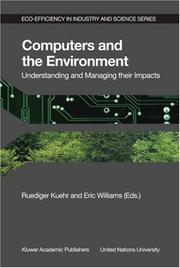
ISBN: 1402016808 9401000336 1402016794 Year: 2003 Publisher: Dordrecht Kluwer Academic
Abstract | Keywords | Export | Availability | Bookmark
 Loading...
Loading...Choose an application
- Reference Manager
- EndNote
- RefWorks (Direct export to RefWorks)
Personal computers have made life convenient in many ways, but what about their impacts on the environment due to production, use and disposal? Manufacturing computers requires prodigious quantities of fossil fuels, toxic chemicals and water. Rapid improvements in performance mean we often buy a new machine every 1-3 years, which adds up to mountains of waste computers. How should societies respond to manage these environmental impacts? This volume addresses the environmental impacts and management of computers through a set of analyses on issues ranging from environmental assessment, technologies for recycling, consumer behaviour, strategies of computer manufacturing firms, and government policies. One conclusion is that extending the lifespan of computers (e.g. through reselling) is an environmentally and economically effective strategy that deserves more attention from governments, firms and the general public.
504 --- 681.3*D26 --- 681.3*I6 --- 681.3*I6 Simulation and modeling (Computing methodologies)--See also {681.3*G3} --- Simulation and modeling (Computing methodologies)--See also {681.3*G3} --- 681.3*D26 Programming environments: interactive (Software engineering) --- Programming environments: interactive (Software engineering) --- 504 Environment. Environmental science --- Environment. Environmental science --- Air pollution. --- Waste management. --- Environmental management. --- Management information systems. --- Computer science. --- Atmospheric Protection/Air Quality Control/Air Pollution. --- Waste Management/Waste Technology. --- Environmental Management. --- Management of Computing and Information Systems. --- Informatics --- Science --- Computer-based information systems --- EIS (Information systems) --- Executive information systems --- MIS (Information systems) --- Sociotechnical systems --- Information resources management --- Management --- Environmental stewardship --- Stewardship, Environmental --- Environmental sciences --- Air --- Air contaminants --- Air pollutants --- Air pollution --- Air pollution control --- Air toxics --- Airborne pollutants --- Atmosphere --- Contaminants, Air --- Control of air pollution --- Pollutants, Air --- Toxics, Air --- Pollution --- Air quality --- Atmospheric deposition --- Communication systems --- Control
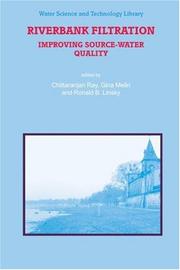
ISBN: 0306481545 1402011334 Year: 2003 Publisher: Dordrecht : Springer Netherlands,
Abstract | Keywords | Export | Availability | Bookmark
 Loading...
Loading...Choose an application
- Reference Manager
- EndNote
- RefWorks (Direct export to RefWorks)
Chittaranjan Ray, Ph. D. , P. E. University of Hawaii at Mãnoa Honolulu, Hawaii, United States Jürgen Schubert, M. Sc. Stadtwerke Düsseldorf AG Düsseldorf, Germany Ronald B. Linsky National Water Research Institute Fountain Valley, California, United States Gina Melin National Water Research Institute Fountain Valley, California, United States 1. What is Riverbank Filtration? The purpose ofthis book is to show that riverbank filtration (RBF) isa low-cost and efficient alternative water treatment for drinking-water applications. There are two immediate benefits to the increased use of RBF: Minimized need for adding chemicals like disinfectants and coagulants to surface water to control pathogens. Decreased costs to the community without increased risk to human health. Butwhat,exactly, isRBF? In humid regions, river water naturally percolates through the ground into aquifers (which are layers of sand and gravel that contain water underground) during high-flow conditions. In arid regions, most rivers lose flow, and the percolating water passes through soil and aquifer material until it reaches the water table. During these percolation processes, potential contaminants present in river water are filtered and attenuated. If there are no other contaminants present in the aquifer or ifthe respective contaminants are present at lower concentrations, the quality of water in the aquifer can be ofhigher quality than that found in theriver. In RBF, production wells — which are placed near the banks ofrivers —pump large quantities ofwater.
Environment. --- Geochemistry. --- Hydrogeology. --- Air pollution. --- Water pollution. --- Waste Water Technology / Water Pollution Control / Water Management / Aquatic Pollution. --- Atmospheric Protection/Air Quality Control/Air Pollution. --- Water --- Purification --- Riverbank filtration. --- Aquatic pollution --- Fresh water --- Fresh water pollution --- Freshwater pollution --- Inland water pollution --- Lake pollution --- Lakes --- Reservoirs --- River pollution --- Rivers --- Stream pollution --- Water contamination --- Water pollutants --- Water pollution --- Pollution --- Waste disposal in rivers, lakes, etc. --- Air --- Air contaminants --- Air pollutants --- Air pollution --- Air pollution control --- Air toxics --- Airborne pollutants --- Atmosphere --- Contaminants, Air --- Control of air pollution --- Pollutants, Air --- Toxics, Air --- Air quality --- Atmospheric deposition --- Geohydrology --- Geology --- Hydrology --- Groundwater --- Chemical composition of the earth --- Chemical geology --- Geological chemistry --- Geology, Chemical --- Chemistry --- Earth sciences --- Riverbank filtration --- Riverbank infiltration --- Control --- Filtration --- Pollution.
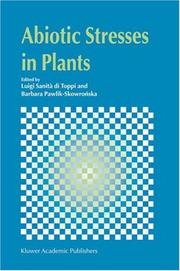
ISBN: 1402016484 9048164346 9401702551 9781402016486 Year: 2003 Publisher: Dordrecht: Kluwer Academic Publishers,
Abstract | Keywords | Export | Availability | Bookmark
 Loading...
Loading...Choose an application
- Reference Manager
- EndNote
- RefWorks (Direct export to RefWorks)
Much of Europe has been complaining recently of unseasonal weathe- disastrous floods in Eastern Europe, temperatures reaching over 40"C in Central Europe, no decent rain for months in parts of the Balkans, coupled with unusually long and severe frosts in winter. Indeed, wheat yields in Serbia for 2003 are expected to be reduced by over 30% because of the combination of a long frost during winter with insufficient protective snow cover, very low rainfall in the spring months and sudden high temperatures reaching over 30·C at the time of flowering. So, with this background, it is very timely that this volume on Abiotic Stresses in Plants has been put together. Each of the eight chapters focuses on a different aspect of abiotic stress, presenting reviews of recent advances in the subject. Rather than summarise the contents of each chapter, I'll focus on some of the advances in technologies presented here for elucidating the molecular, genetic and biochemical mechanisms that regulate plant responses to stresses and which also provide opportunities for improving plant performance under abiotic stresses. The last 20 years has seen a revolution in the availability of technologies for this, starting with the development of transformation technologies to study the role of an individual gene, then came molecular marker technologies to study the genetic control of stress responses, and in recent years the '-omics' (genomics, proteomics and metabolomics) have been developed to create an integrated picture of how the plant responds to a particular stress.
Crops --- Effect of stress on. --- Physiology. --- 58.02 --- 632.11 --- 632.12 --- 632.15 --- 632.18 --- Effect of external factors. Collective effect of several factors. Stress --- Unfavourable meteorological or climatic conditions. Damage by weather --- Unfavourable soil conditions --- Atmospheric impurities. Chemical or industrial pollution --- Other non-parasitic complaints. Mechanical injuries. Fire damage. Bomb and blast damage --- Plant and Crop Sciences. Crops --- Crops (General) --- Crops (General). --- 632.18 Other non-parasitic complaints. Mechanical injuries. Fire damage. Bomb and blast damage --- 632.15 Atmospheric impurities. Chemical or industrial pollution --- 632.12 Unfavourable soil conditions --- 632.11 Unfavourable meteorological or climatic conditions. Damage by weather --- 58.02 Effect of external factors. Collective effect of several factors. Stress --- Plant physiology --- Stress (Physiology) --- Effect of stress on --- Physiology --- Plant physiology. --- Plant science. --- Botany. --- Air pollution. --- Climate change. --- Plant Physiology. --- Plant Sciences. --- Atmospheric Protection/Air Quality Control/Air Pollution. --- Climate Change. --- Changes, Climatic --- Changes in climate --- Climate change --- Climate change science --- Climate changes --- Climate variations --- Climatic change --- Climatic changes --- Climatic fluctuations --- Climatic variations --- Global climate changes --- Global climatic changes --- Climatology --- Climate change mitigation --- Teleconnections (Climatology) --- Air --- Air contaminants --- Air pollutants --- Air pollution --- Air pollution control --- Air toxics --- Airborne pollutants --- Atmosphere --- Contaminants, Air --- Control of air pollution --- Pollutants, Air --- Toxics, Air --- Pollution --- Air quality --- Atmospheric deposition --- Botanical science --- Phytobiology --- Phytography --- Phytology --- Plant biology --- Plant science --- Biology --- Natural history --- Plants --- Botany --- Environmental aspects --- Control --- Floristic botany --- Crops - Effect of stress on. --- Crops - Physiology.
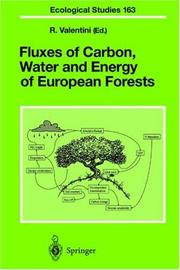
ISSN: 00708356 ISBN: 3540437916 3642078486 3662051710 9783540437918 Year: 2003 Volume: 163 Publisher: Berlin: Springer,
Abstract | Keywords | Export | Availability | Bookmark
 Loading...
Loading...Choose an application
- Reference Manager
- EndNote
- RefWorks (Direct export to RefWorks)
After years of technological development and its important achievements to make our life easier and more comfortable, human society is going to face one of the most difficult challenges of the last century: to stabilize the concentra tion levels of greenhouse gases in the atmosphere to prevent harmful effects on the climate system. Through a delicate balance between photosynthesis and respiration, terres trial ecosystems, and in particular forests, are today thought to take up a sig nificant part of the carbon dioxide emissions in the atmosphere, sometimes called the "terrestrial carbon sink". However, the location, magnitude, and vulnerability of the carbon dioxide sink of the terrestrial biota are still uncer tain. The suite of traditional tools in an ecologist's toolbox for studying ecosys tem productivity and carbon balance include leaf cuvettes, whole-plant and soil chambers for gas exchange, and biomass and soil carbon inventories. While each of the cited methods has distinct advantages, they are limited with regards to their ability to measure net carbon dioxide exchange of the whole ecosystem across a variety of time scales. This book present a compendium of results of a European project (EURO FLUX), funded by the European Commission through its fourth framework program, aiming to elucidate the role of forests in continental carbon balance.
Plant ecology. Plant sociology --- Geochemistry --- Forestry --- Europe --- forests --- Dioxyde de carbone --- carbon dioxide --- water --- Rayonnement thermique --- Thermal radiation --- Cycle biogéochimique --- cycling --- Relation source puits --- Source sink relations --- Modèle dynamique --- Dynamic models --- Carbon cycle (Biogeochemistry) --- -630*18 --- Forest ecology --- -Forests and forestry --- Ecology --- Global carbon cycle --- Biogeochemical cycles --- Plant ecology --- Environmental Sciences and Forestry. Forestry --- Forest Ecology --- Forest Ecology. --- -Plant ecology --- 630*18 Plant ecology --- -630*18 Plant ecology --- Forests and forestry --- 630*18 --- Forest ecosystems --- Forestry. --- Ecology . --- Geoecology. --- Environmental geology. --- Air pollution. --- Nature conservation. --- Climate change. --- Terrestial Ecology. --- Geoecology/Natural Processes. --- Atmospheric Protection/Air Quality Control/Air Pollution. --- Nature Conservation. --- Climate Change. --- Changes, Climatic --- Changes in climate --- Climate change --- Climate change science --- Climate changes --- Climate variations --- Climatic change --- Climatic changes --- Climatic fluctuations --- Climatic variations --- Global climate changes --- Global climatic changes --- Climatology --- Climate change mitigation --- Teleconnections (Climatology) --- Conservation of nature --- Nature --- Nature protection --- Protection of nature --- Conservation of natural resources --- Applied ecology --- Conservation biology --- Endangered ecosystems --- Natural areas --- Air --- Air contaminants --- Air pollutants --- Air pollution --- Air pollution control --- Air toxics --- Airborne pollutants --- Atmosphere --- Contaminants, Air --- Control of air pollution --- Pollutants, Air --- Toxics, Air --- Pollution --- Air quality --- Atmospheric deposition --- Geoecology --- Environmental protection --- Physical geology --- Balance of nature --- Biology --- Bionomics --- Ecological processes --- Ecological science --- Ecological sciences --- Environment --- Environmental biology --- Oecology --- Environmental sciences --- Population biology --- Forest land --- Forest lands --- Forest planting --- Forest production --- Forest sciences --- Forestation --- Forested lands --- Forestland --- Forestlands --- Forestry industry --- Forestry sciences --- Land, Forest --- Lands, Forest --- Silviculture --- Sylviculture --- Woodlands --- Woods (Forests) --- Agriculture --- Natural resources --- Afforestation --- Arboriculture --- Logging --- Timber --- Tree crops --- Trees --- Environmental aspects --- Conservation --- Control --- Carbon cycle (Biogeochemistry) - Europe --- Forest ecology - Europe
| Listing 1 - 10 of 10 |
Sort by
|

 Search
Search Feedback
Feedback About UniCat
About UniCat  Help
Help News
News